Abstract
1. Eye movements have been recorded in man in response to various forms of continuous and discontinuous target motions in the horizontal plane in an attempt to establish the mechanisms of prediction in the pursuit reflex. 2. In an initial experiment the target motion was composed of four sinusoids, each of peak velocity +/- 3.3 deg/s. The three lowest frequencies (0.11, 0.24 and 0.37 Hz) remained constant whereas the highest frequency (F4) was varied from 0.39 to 2.08 Hz. When F4 was 0.39 Hz, all frequency components had a high level of eye velocity gain (mean 0.92) but as F4 was increased there was a significant (P less than 0.001) decline in gain for all three low frequencies which reached a minimum (mean 0.53) when F4 was 1.56 Hz. However, the gain for F4 always remained at a high level, comparable to that evoked by a discrete frequency sinusoid of the same frequency. 3. When the highest-frequency sinusoid was replaced by a square wave of identical amplitude a similar decline in gain for the low frequencies was observed. Eye velocity exhibited a quasi-sinusoidal modulation at the frequency of the square wave even though the rapid steps did not constitute a suitable stimulus to the visual velocity feed-back mechanisms. 4. When only two sinusoids were mixed to form the pursuit stimulus a similar break-down in gain of the lower-frequency component was observed which reached a minimum (mean gain 0.58) when F2 was between 1 and 2 Hz. This implies that the predictability of stimulus motion is dependent, not on the complexity of the stimulus, but on its highest-frequency component. 5. Presentation of square-wave target displacements alone confirmed that smooth eye movements could be evoked by such a stimulus. Eye velocity was at a maximum between 1.0 and 1.5 Hz and was predictive of ensuing target displacement. Responses to staircase step sequences of varying duration indicated that prediction was based on an assessment of the duration of the preceding sequence. 6. Tachistoscopic presentation of targets during low-frequency sinusoidal oscillation indicated that illumination of the target for very short periods (10-320 ms) as few as two times per cycle during minimum velocity phases enhanced the perception of continuous movement. A predictive eye movement was evoked with a high level of peak velocity which then decayed until the subsequent exposure of the target.(ABSTRACT TRUNCATED AT 400 WORDS)
Full text
PDF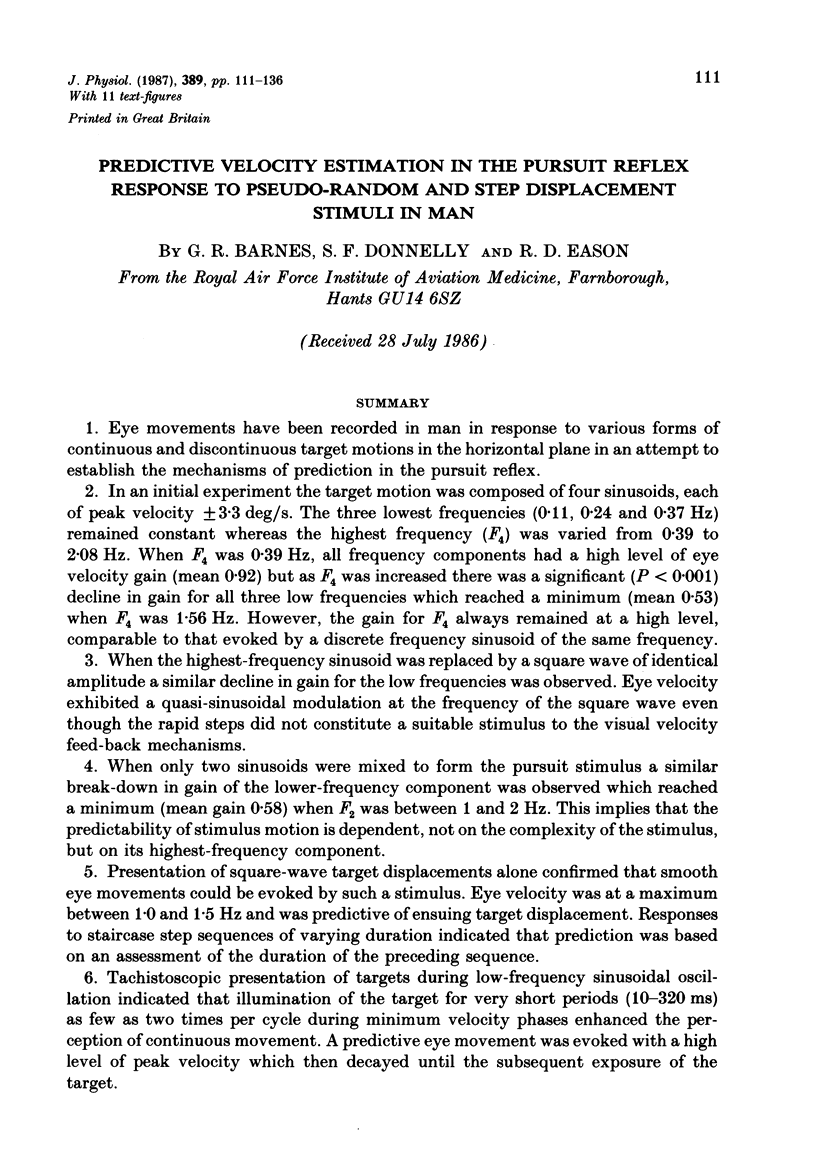
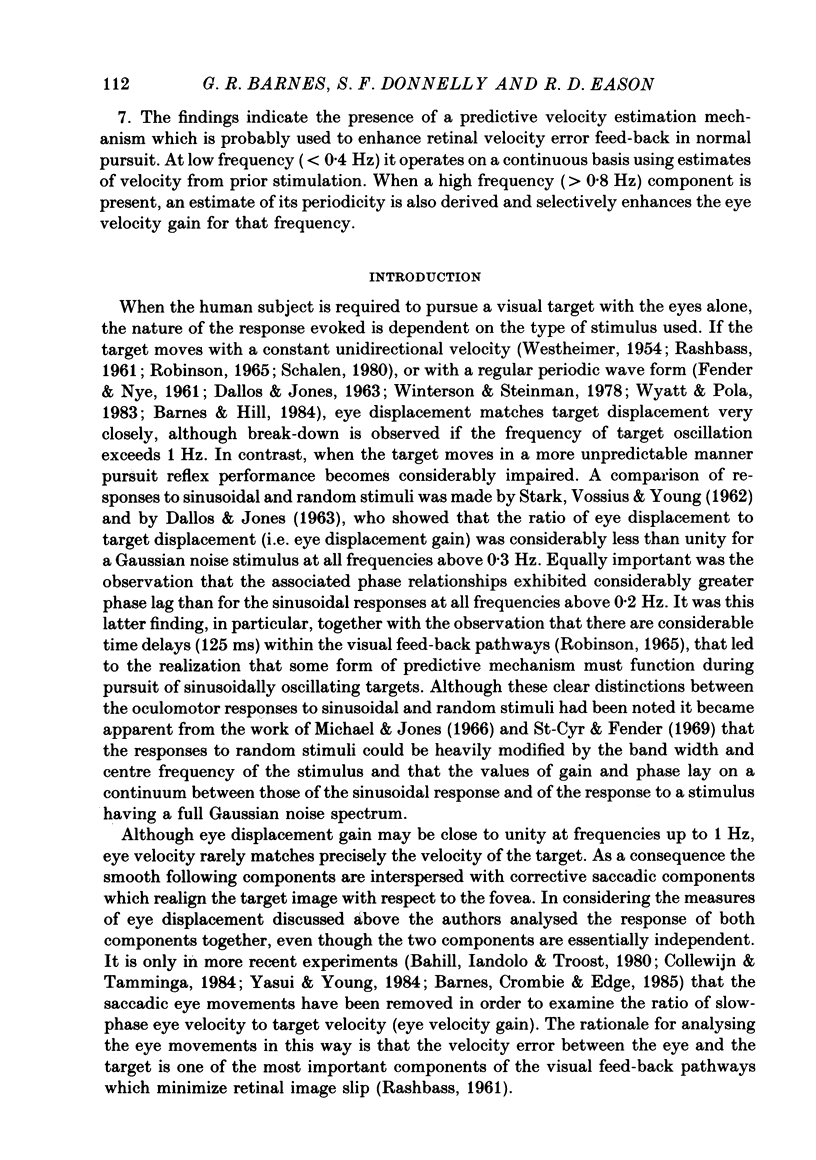
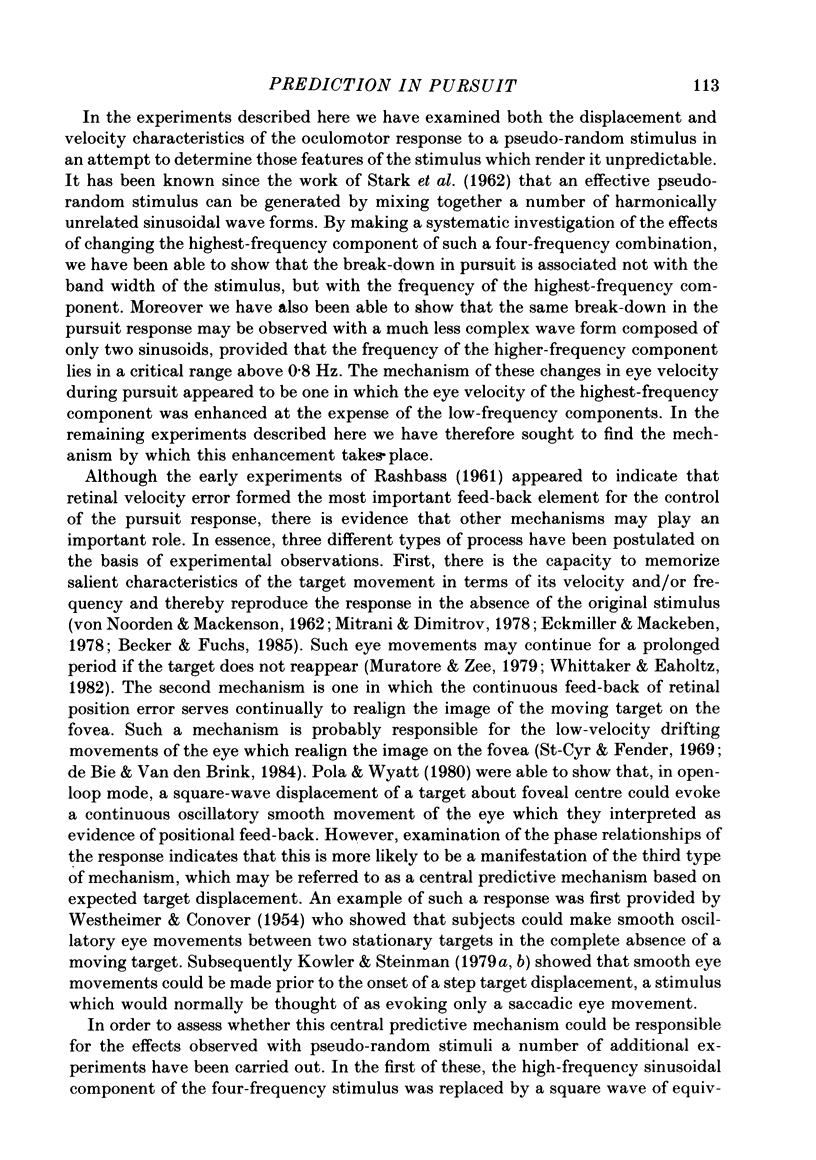
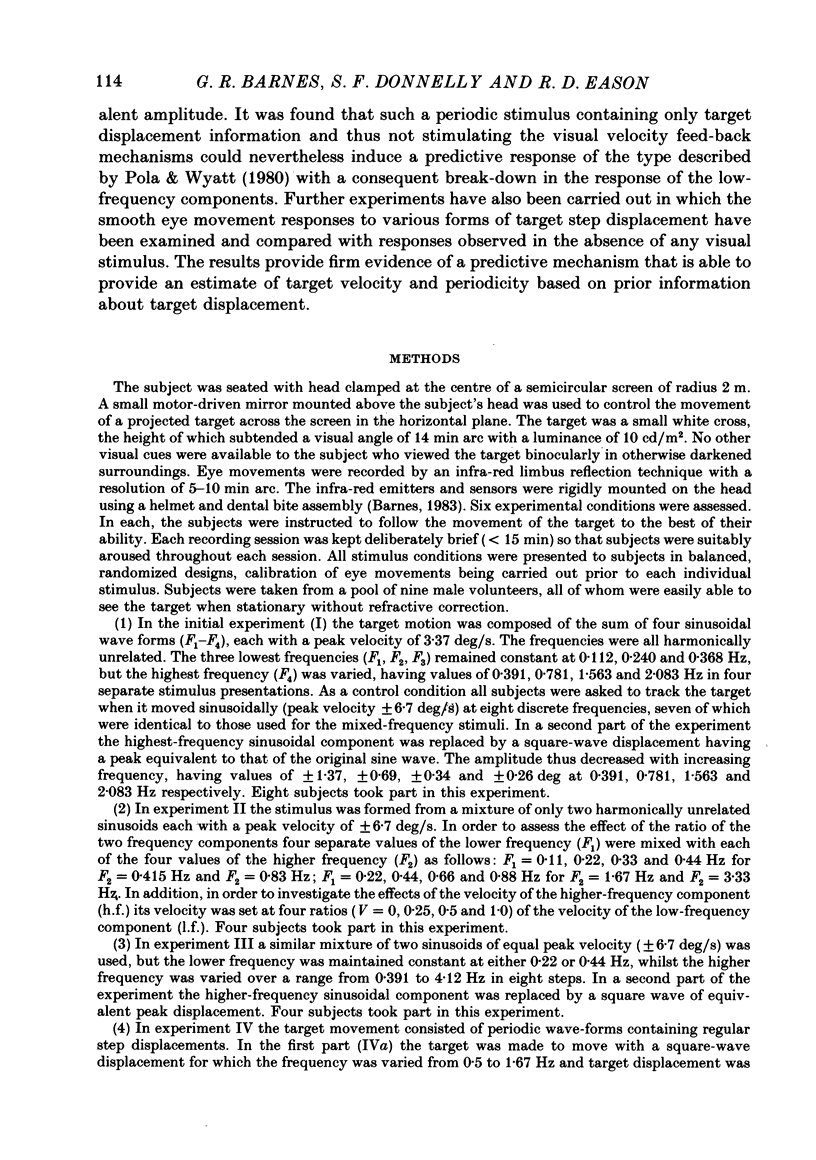
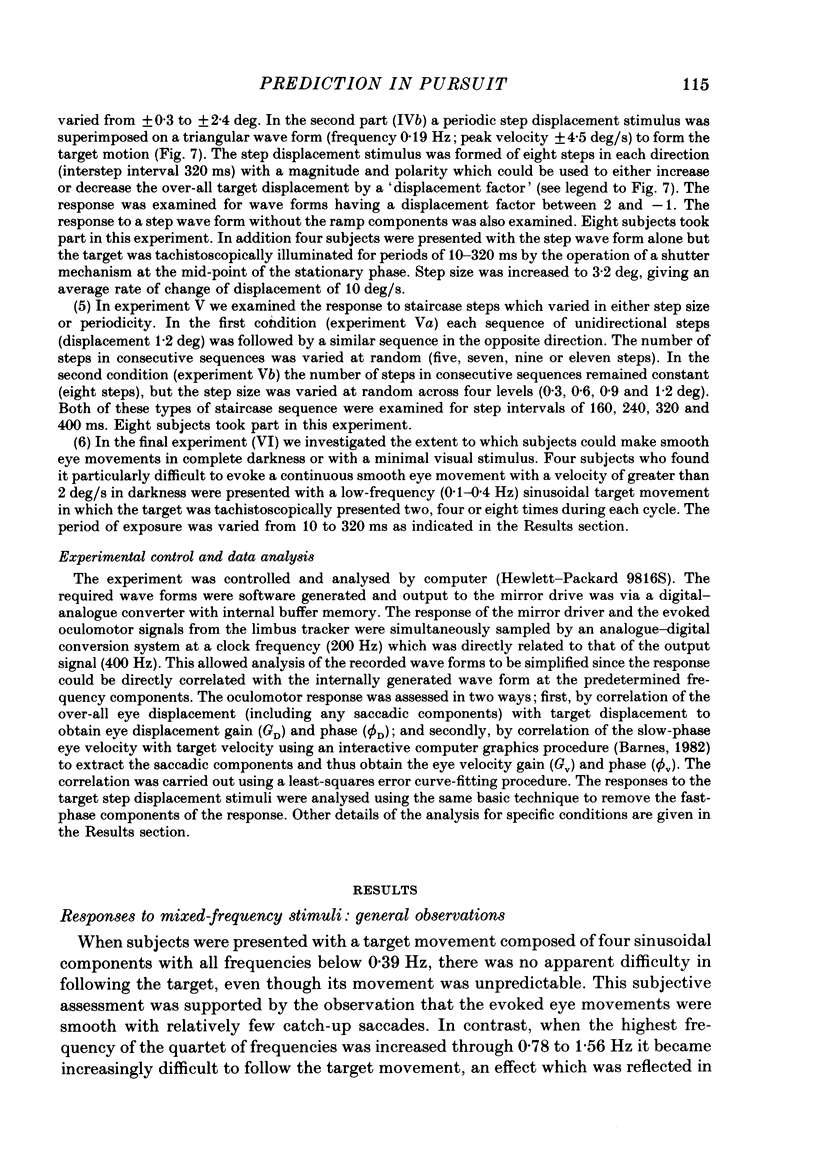
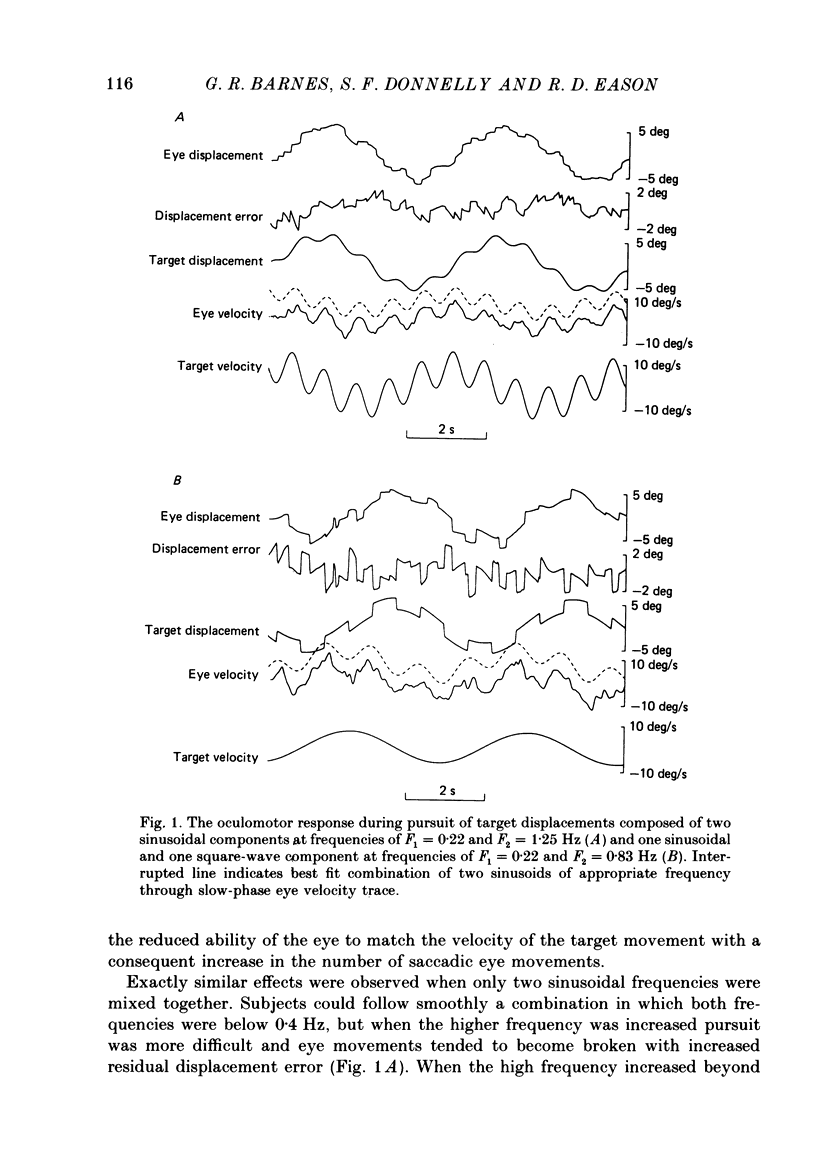



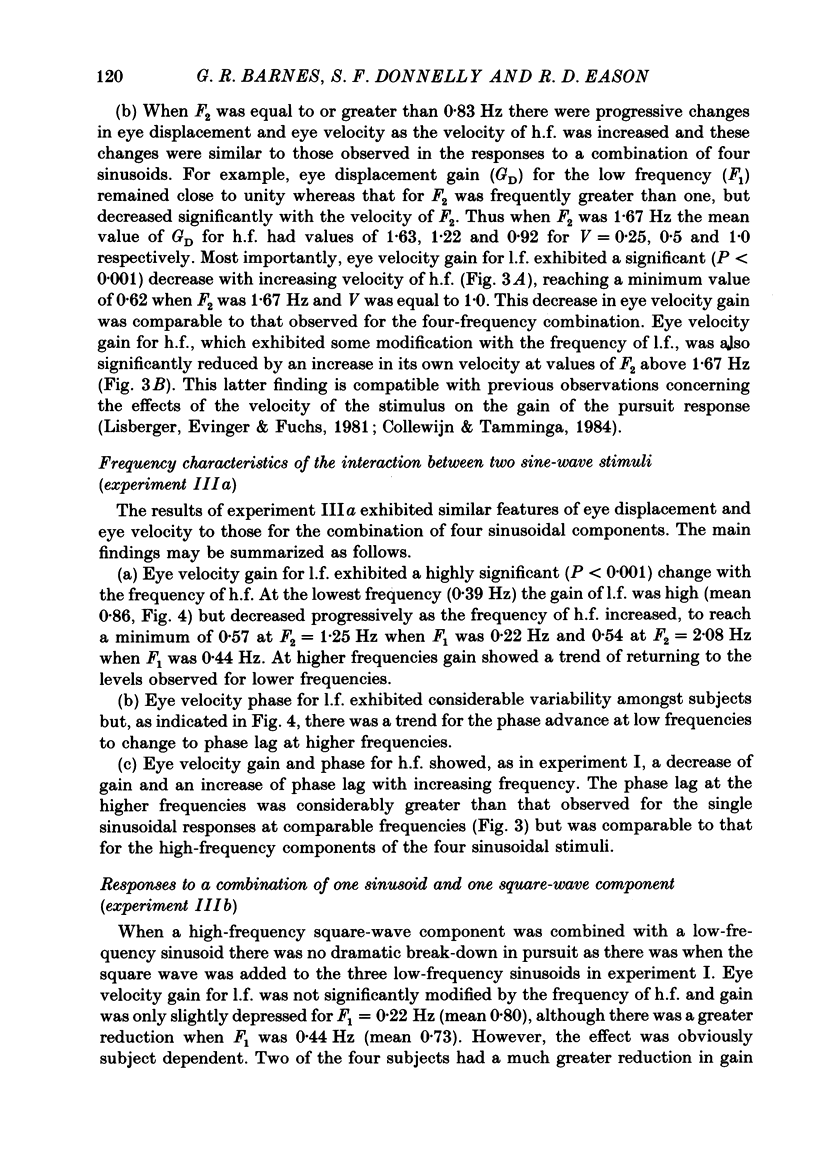

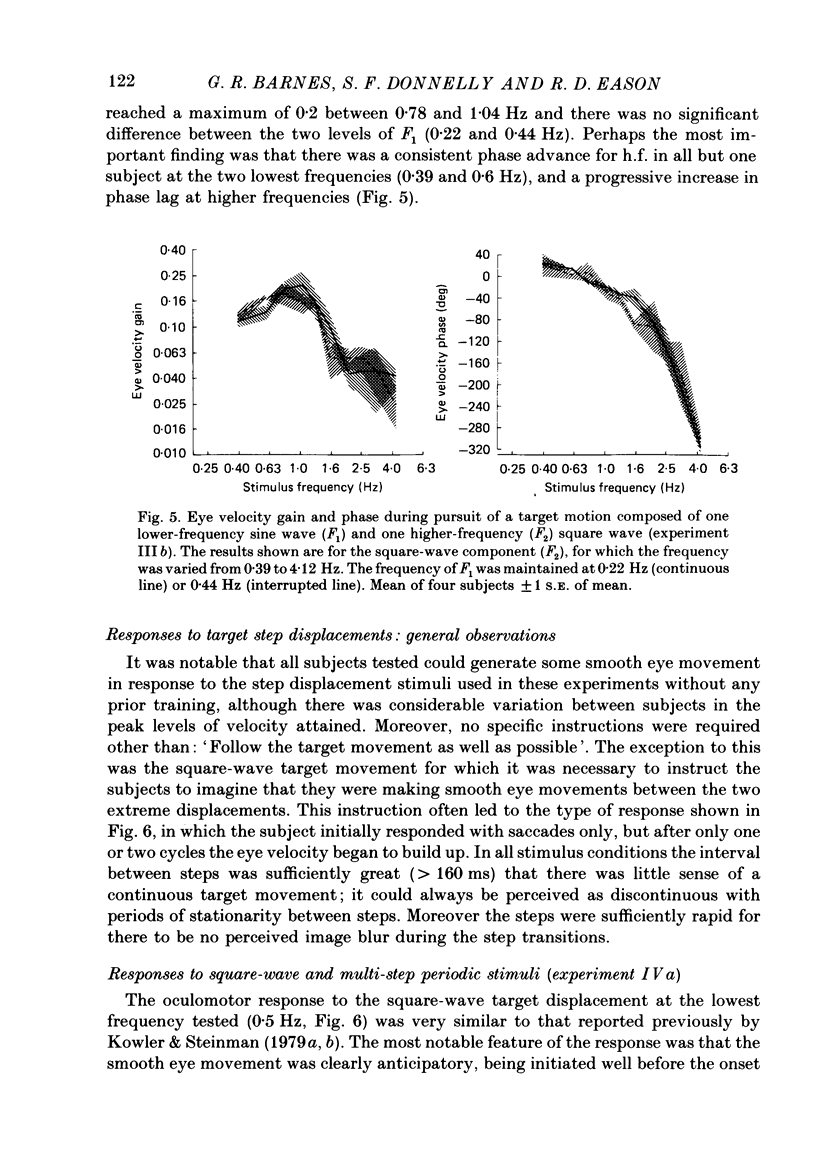
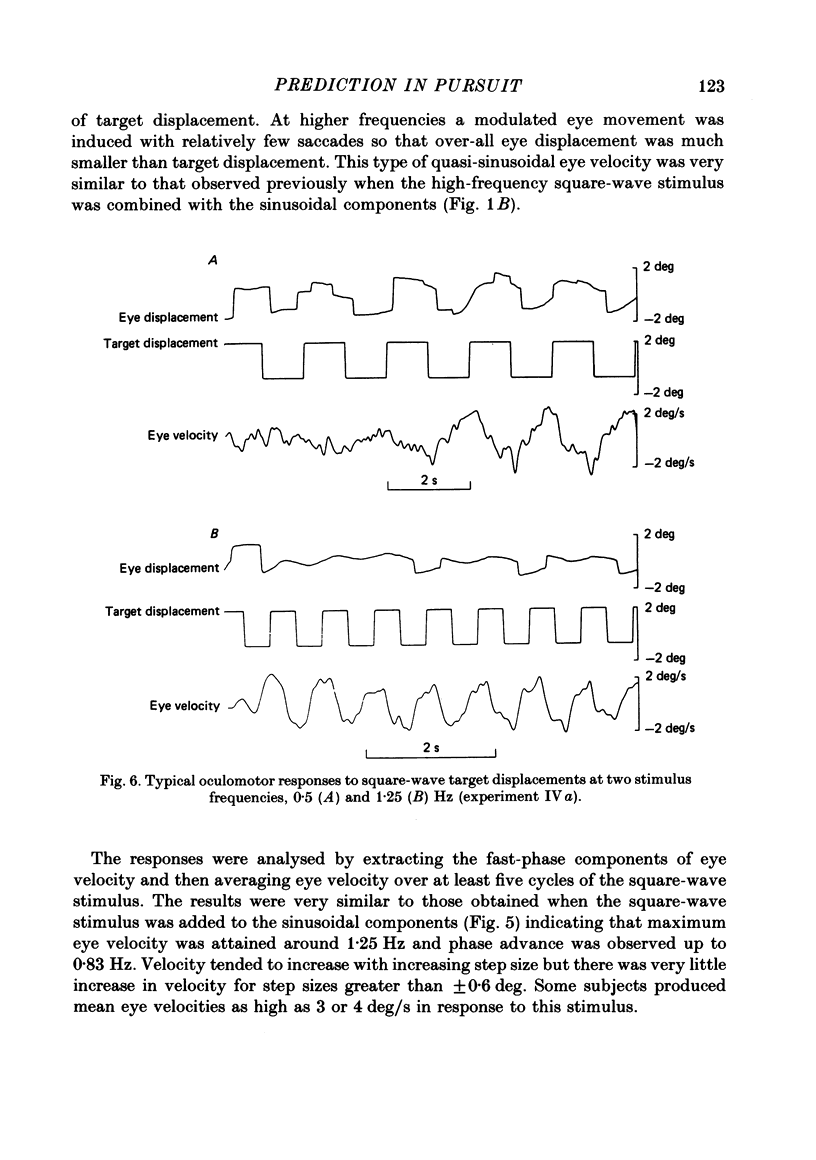


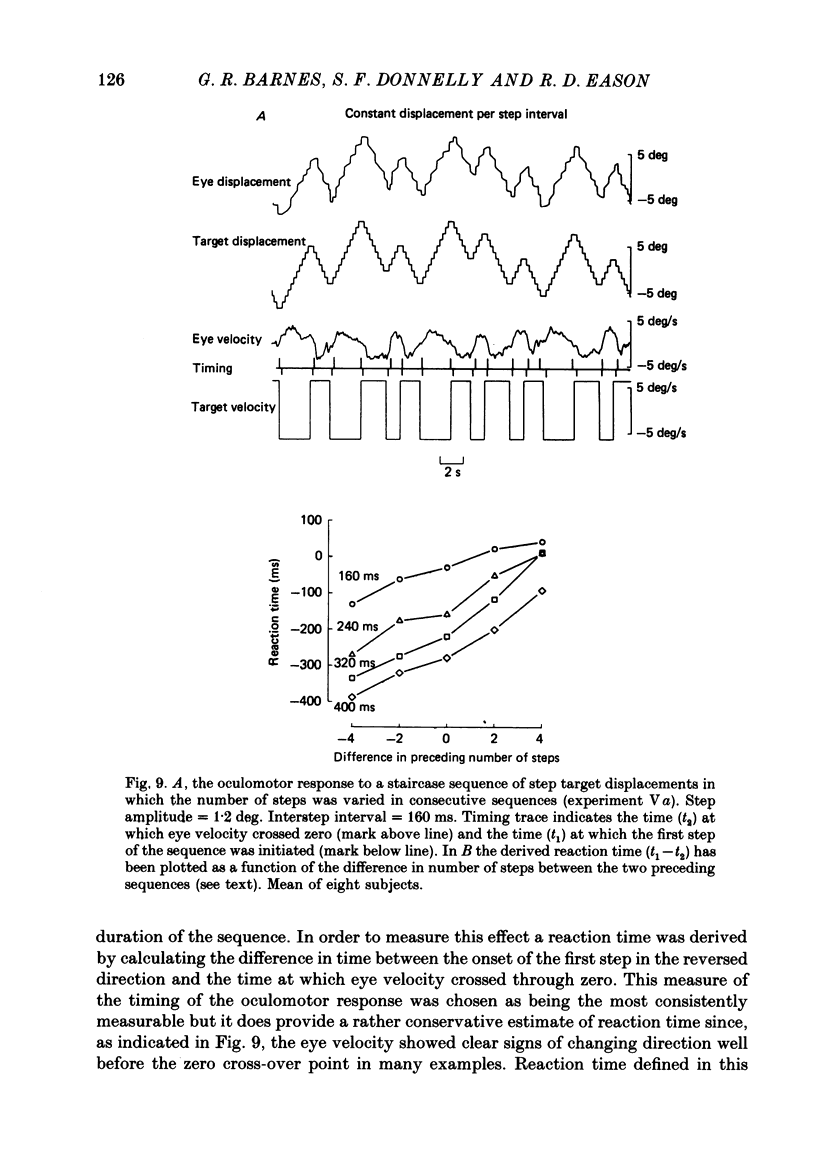
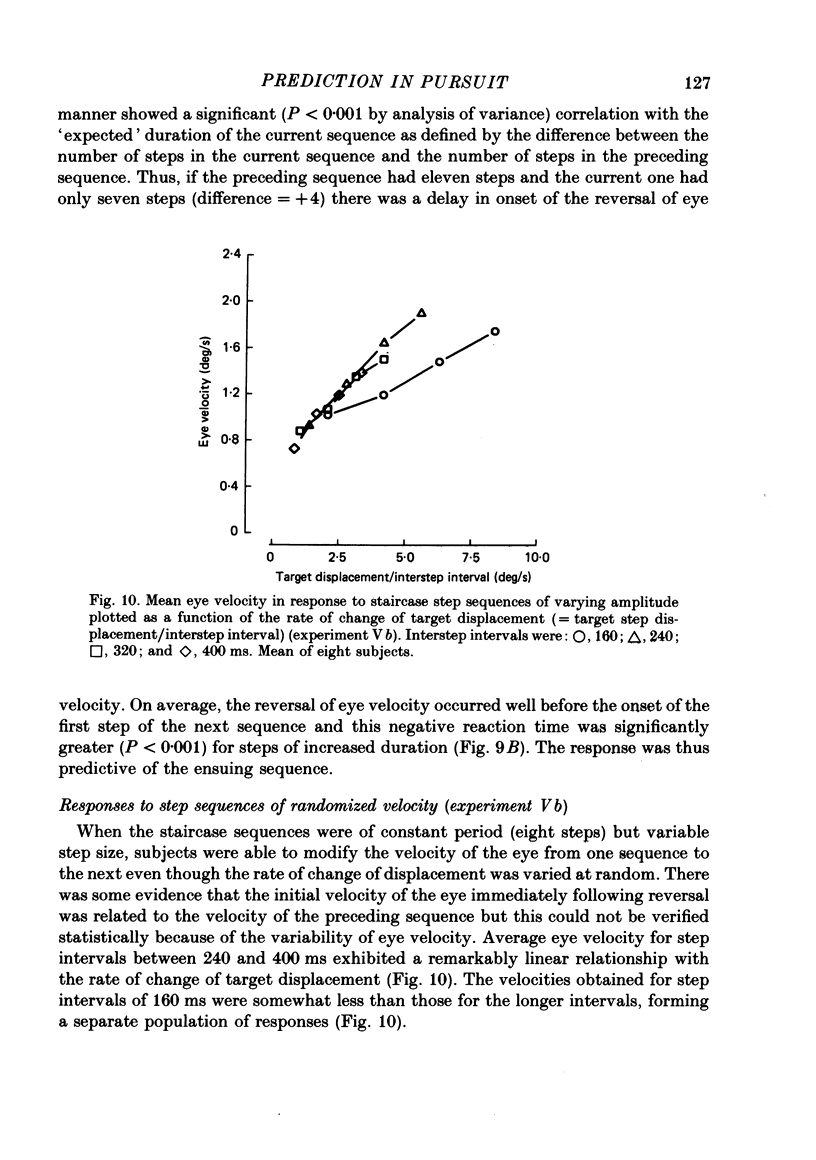
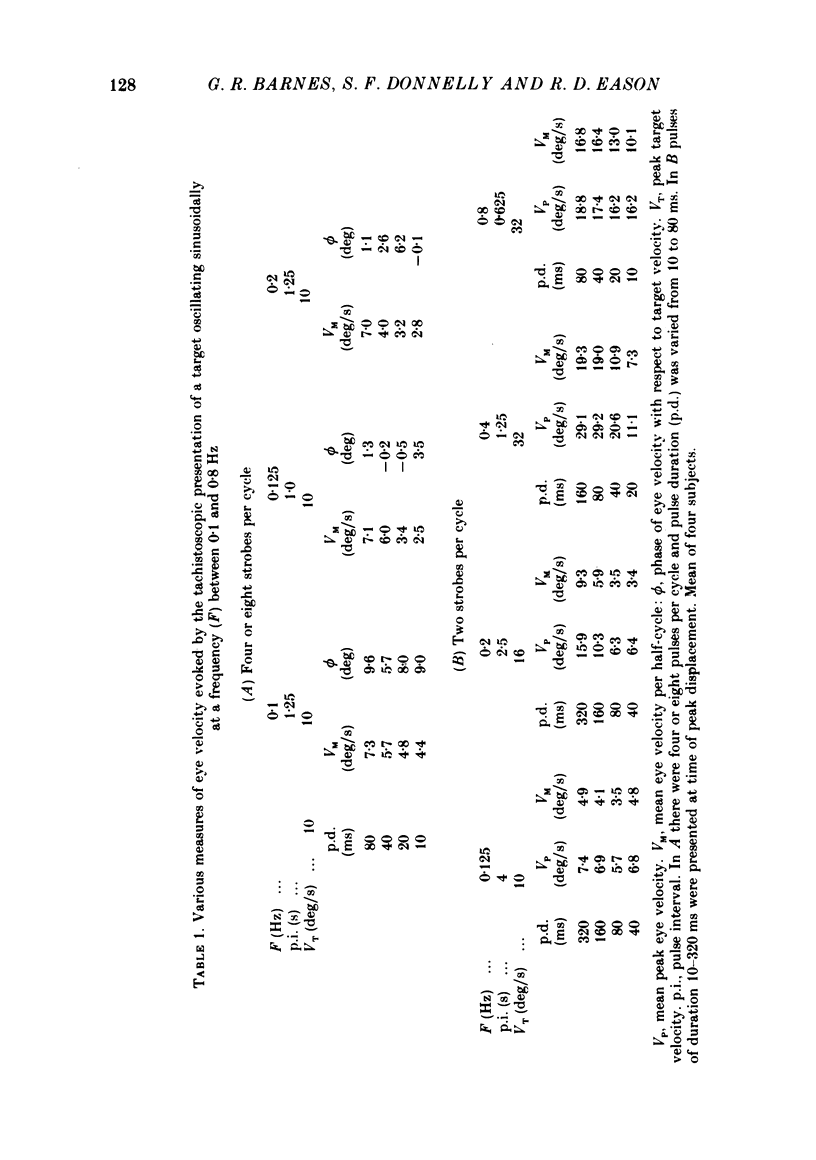


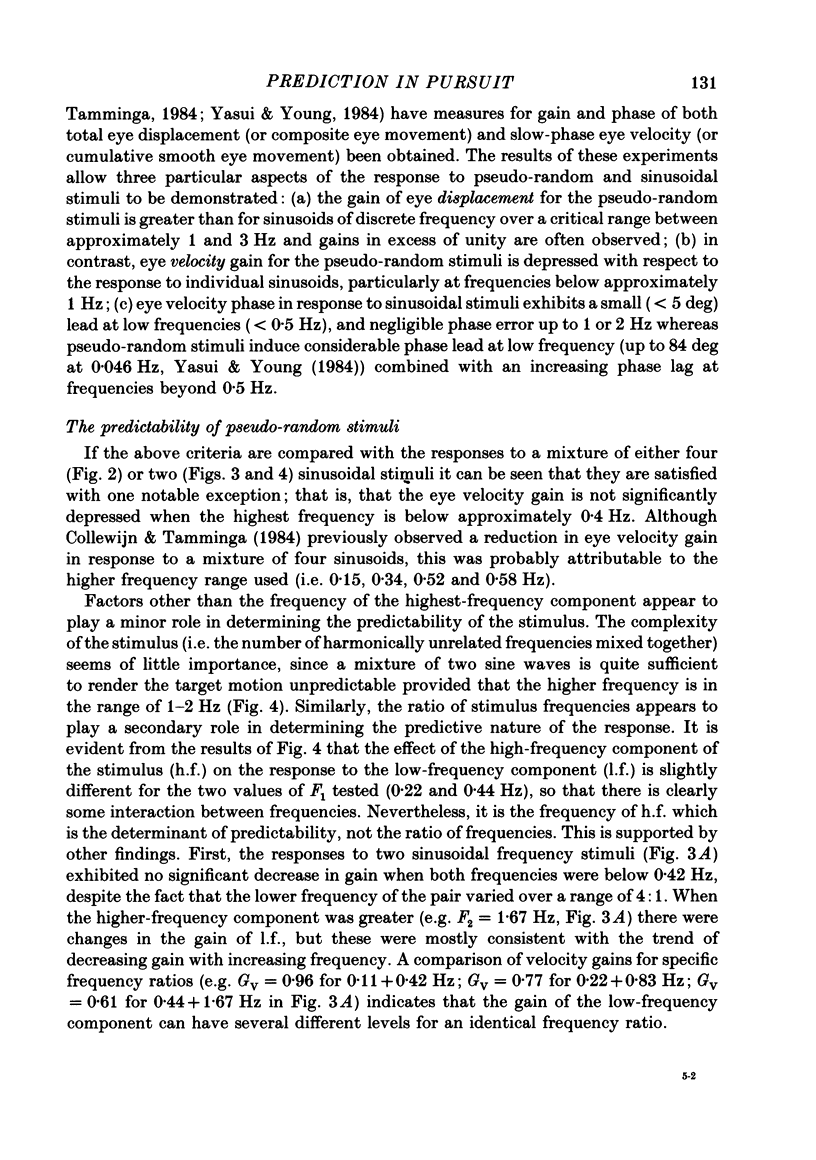
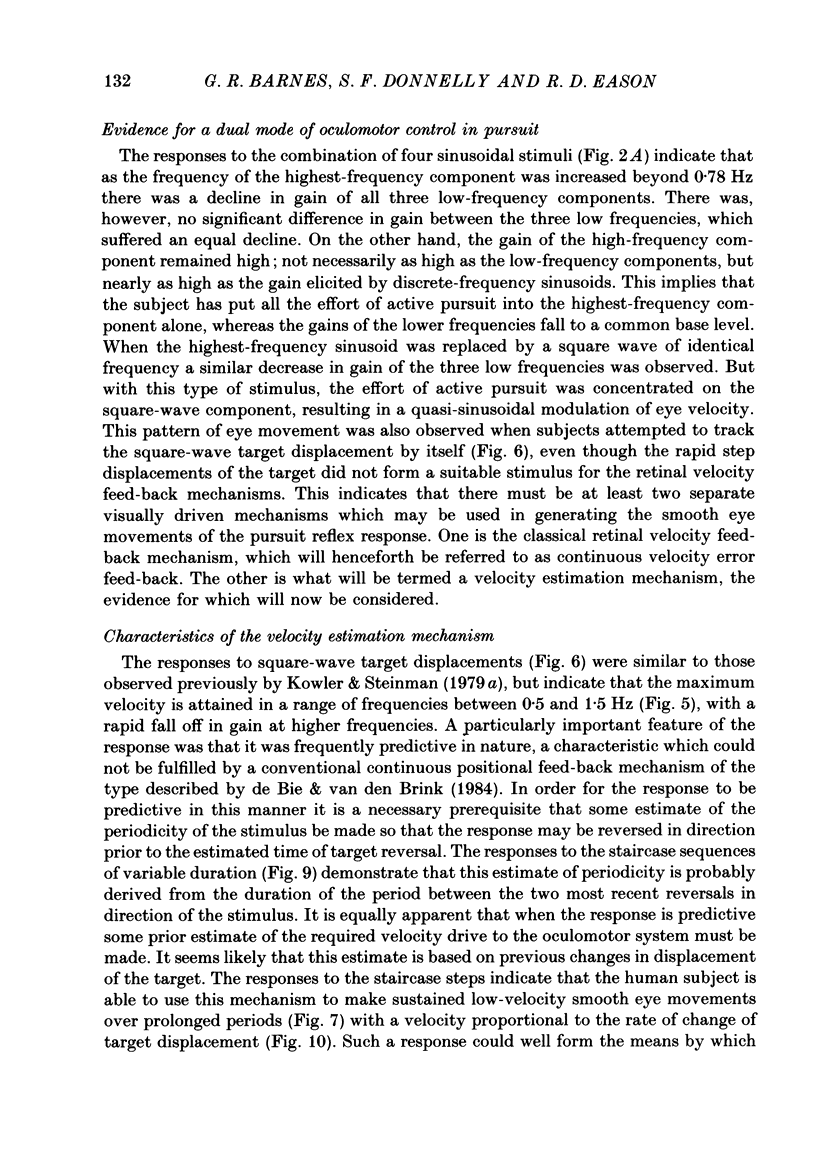
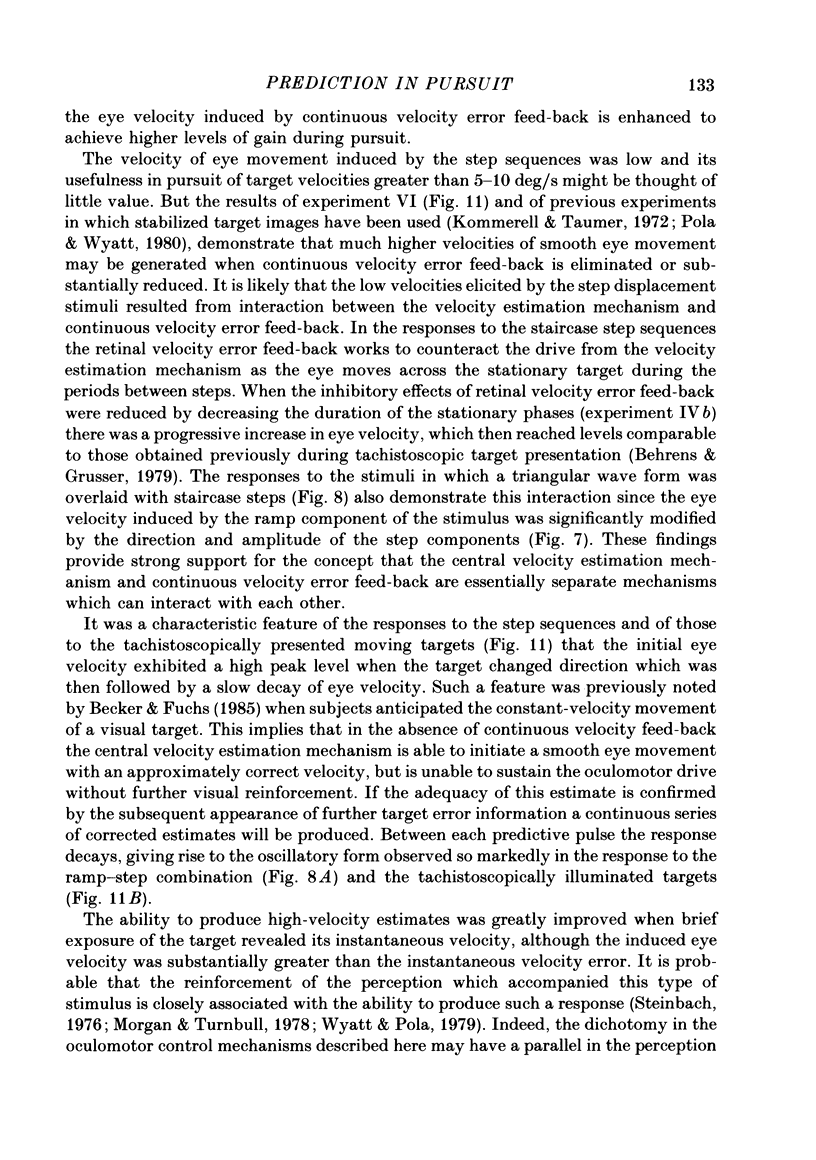
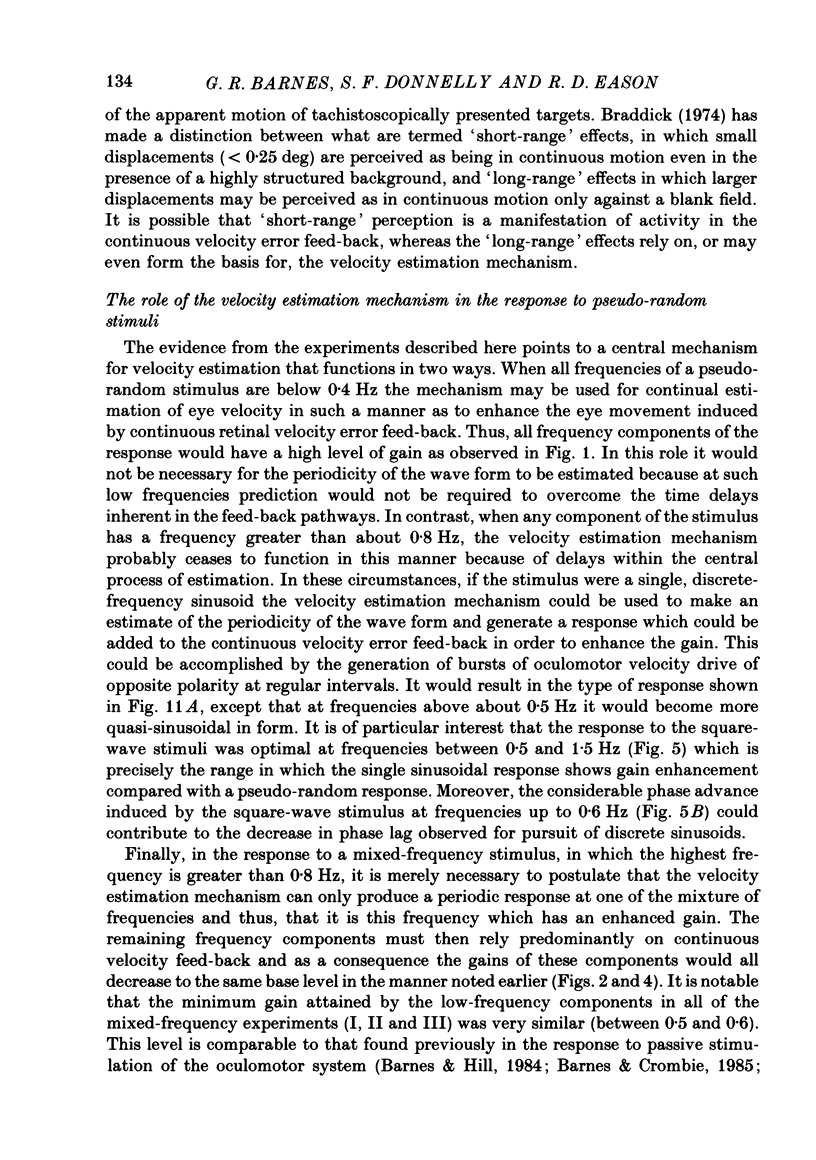
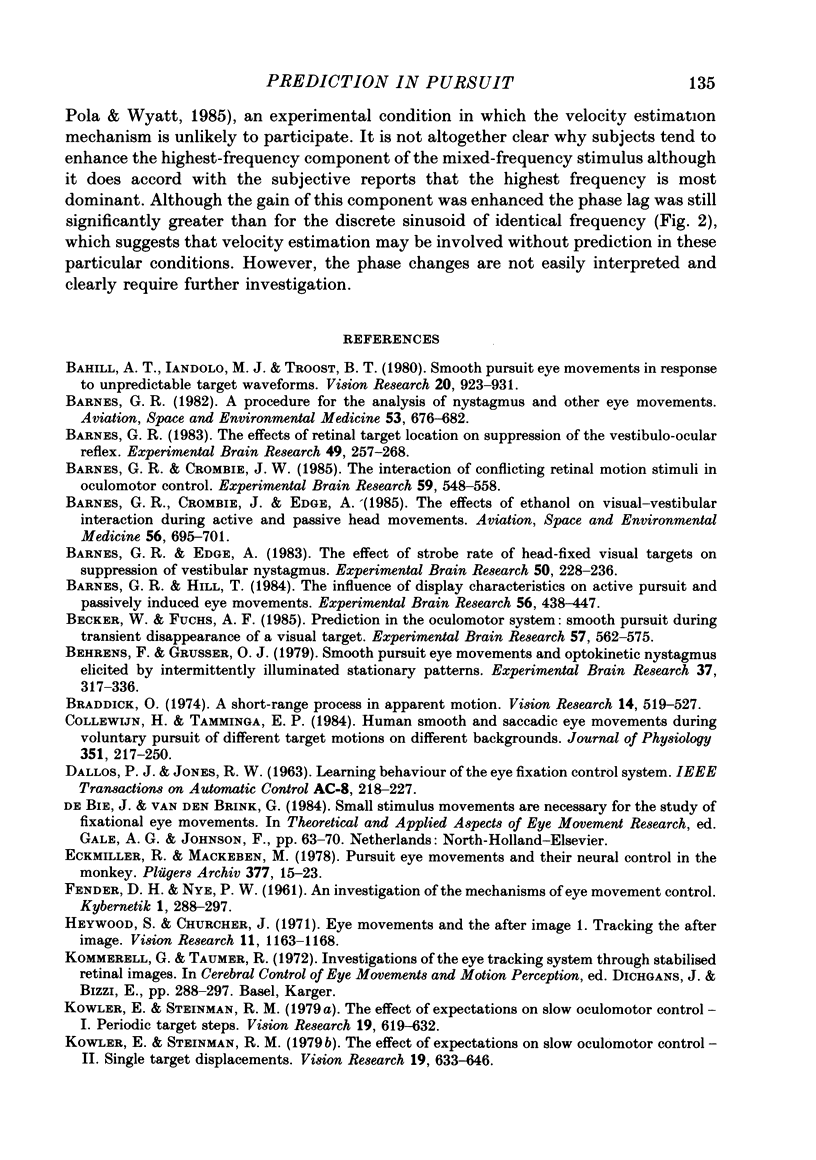

Selected References
These references are in PubMed. This may not be the complete list of references from this article.
- Bahill A. T., Iandolo M. J., Troost B. T. Smooth pursuit eye movements in response to unpredictable target waveforms. Vision Res. 1980;20(11):923–931. doi: 10.1016/0042-6989(80)90073-5. [DOI] [PubMed] [Google Scholar]
- Barnes G. R. A procedure for the analysis of nystagmus and other eye movements. Aviat Space Environ Med. 1982 Jul;53(7):676–682. [PubMed] [Google Scholar]
- Barnes G. R., Crombie J. W., Edge A. The effects of ethanol on visual-vestibular interaction during active and passive head movements. Aviat Space Environ Med. 1985 Jul;56(7):695–701. [PubMed] [Google Scholar]
- Barnes G. R., Crombie J. W. The interaction of conflicting retinal motion stimuli in oculomotor control. Exp Brain Res. 1985;59(3):548–558. doi: 10.1007/BF00261346. [DOI] [PubMed] [Google Scholar]
- Barnes G. R., Edge A. The effects of strobe rate of head-fixed visual targets on suppression of vestibular nystagmus. Exp Brain Res. 1983;50(2-3):228–236. doi: 10.1007/BF00239187. [DOI] [PubMed] [Google Scholar]
- Barnes G. R., Hill T. The influence of display characteristics on active pursuit and passively induced eye movements. Exp Brain Res. 1984;56(3):438–447. doi: 10.1007/BF00237984. [DOI] [PubMed] [Google Scholar]
- Barnes G. R. The effects of retinal target location on suppression of the vestibulo-ocular reflex. Exp Brain Res. 1983;49(2):257–268. doi: 10.1007/BF00238585. [DOI] [PubMed] [Google Scholar]
- Becker W., Fuchs A. F. Prediction in the oculomotor system: smooth pursuit during transient disappearance of a visual target. Exp Brain Res. 1985;57(3):562–575. doi: 10.1007/BF00237843. [DOI] [PubMed] [Google Scholar]
- Behrens F., Grüsser O. J. Smooth pursuit eye movements and optokinetic nystagmus elicited by intermittently illuminated stationary patterns. Exp Brain Res. 1979 Oct;37(2):317–336. doi: 10.1007/BF00237717. [DOI] [PubMed] [Google Scholar]
- Braddick O. A short-range process in apparent motion. Vision Res. 1974 Jul;14(7):519–527. doi: 10.1016/0042-6989(74)90041-8. [DOI] [PubMed] [Google Scholar]
- Collewijn H., Tamminga E. P. Human smooth and saccadic eye movements during voluntary pursuit of different target motions on different backgrounds. J Physiol. 1984 Jun;351:217–250. doi: 10.1113/jphysiol.1984.sp015242. [DOI] [PMC free article] [PubMed] [Google Scholar]
- Eckmiller R., Mackeben M. Pursuit eye movements and their neural control in the monkey. Pflugers Arch. 1978 Oct 18;377(1):15–23. doi: 10.1007/BF00584369. [DOI] [PubMed] [Google Scholar]
- Heywood S., Churcher J. Eye movements and the afterimage. I. Tracking the afterimage. Vision Res. 1971 Oct;11(10):1163–1168. doi: 10.1016/0042-6989(71)90120-9. [DOI] [PubMed] [Google Scholar]
- Kommerell G., Täumer R. Investigations of the eye tracking system through stabilized retinal images. Bibl Ophthalmol. 1972;82:288–297. [PubMed] [Google Scholar]
- Kowler E., Steinman R. M. The effect of expectations on slow oculomotor control. I. Periodic target steps. Vision Res. 1979;19(6):619–632. doi: 10.1016/0042-6989(79)90238-4. [DOI] [PubMed] [Google Scholar]
- Kowler E., Steinman R. M. The effect of expectations on slow oculomotor control. II. Single target displacements. Vision Res. 1979;19(6):633–646. doi: 10.1016/0042-6989(79)90239-6. [DOI] [PubMed] [Google Scholar]
- Lisberger S. G., Evinger C., Johanson G. W., Fuchs A. F. Relationship between eye acceleration and retinal image velocity during foveal smooth pursuit in man and monkey. J Neurophysiol. 1981 Aug;46(2):229–249. doi: 10.1152/jn.1981.46.2.229. [DOI] [PubMed] [Google Scholar]
- Michael J. A., Jones G. M. Dependence of visual tracking capability upon stimulus predictability. Vision Res. 1966 Dec;6(12):707–716. doi: 10.1016/0042-6989(66)90082-4. [DOI] [PubMed] [Google Scholar]
- Mitrani L., Dimitrov G. Pursuit eye movements of a disappearing moving target. Vision Res. 1978;18(5):537–539. doi: 10.1016/0042-6989(78)90199-2. [DOI] [PubMed] [Google Scholar]
- Morgan M. J., Turnbull D. F. Smooth eye tracking and the perception of motion in the absence of real movement. Vision Res. 1978;18(8):1053–1059. doi: 10.1016/0042-6989(78)90034-2. [DOI] [PubMed] [Google Scholar]
- Muratore R., Zee D. S. Pursuit after-nystagmus. Vision Res. 1979;19(9):1057–1059. doi: 10.1016/0042-6989(79)90233-5. [DOI] [PubMed] [Google Scholar]
- Pola J., Wyatt H. J. Active and passive smooth eye movements: effects of stimulus size and location. Vision Res. 1985;25(8):1063–1076. doi: 10.1016/0042-6989(85)90094-x. [DOI] [PubMed] [Google Scholar]
- Pola J., Wyatt H. J. Target position and velocity: the stimuli for smooth pursuit eye movements. Vision Res. 1980;20(6):523–534. doi: 10.1016/0042-6989(80)90127-3. [DOI] [PubMed] [Google Scholar]
- Robinson D. A. The mechanics of human smooth pursuit eye movement. J Physiol. 1965 Oct;180(3):569–591. doi: 10.1113/jphysiol.1965.sp007718. [DOI] [PMC free article] [PubMed] [Google Scholar]
- Schalén L. Quantification of tracking eye movements in normal subjects. Acta Otolaryngol. 1980 Nov-Dec;90(5-6):404–413. doi: 10.3109/00016488009131742. [DOI] [PubMed] [Google Scholar]
- St-Cyr G. J., Fender D. H. Nonlinearities of the human oculomotor system: gain. Vision Res. 1969 Oct;9(10):1235–1246. doi: 10.1016/0042-6989(69)90111-4. [DOI] [PubMed] [Google Scholar]
- Steinbach M. J. Pursuing the perceptual rather than the retinal stimulus. Vision Res. 1976;16(12):1371–1376. doi: 10.1016/0042-6989(76)90154-1. [DOI] [PubMed] [Google Scholar]
- VON NOORDEN G. K., MACKENSEN G. Pursuit movements of normal and amblyopic eyes. An electro-ophthalmographic study. 1. Physiology of pursuit movements. Am J Ophthalmol. 1962 Feb;53:325–336. doi: 10.1016/0002-9394(62)91183-2. [DOI] [PubMed] [Google Scholar]
- WESTHEIMER G., CONOVER D. W. Smooth eye movements in the absence of a moving visual stimulus. J Exp Psychol. 1954 Apr;47(4):283–284. doi: 10.1037/h0058502. [DOI] [PubMed] [Google Scholar]
- WESTHEIMER G. Eye movement responses to a horizontally moving visual stimulus. AMA Arch Ophthalmol. 1954 Dec;52(6):932–941. doi: 10.1001/archopht.1954.00920050938013. [DOI] [PubMed] [Google Scholar]
- Whittaker S. G., Eaholtz G. Learning patterns of eye motion for foveal pursuit. Invest Ophthalmol Vis Sci. 1982 Sep;23(3):393–397. [PubMed] [Google Scholar]
- Winterson B. J., Steinman R. M. The effect of luminance on human smooth pursuit of perifoveal and foveal targets. Vision Res. 1978;18(9):1165–1172. doi: 10.1016/0042-6989(78)90100-1. [DOI] [PubMed] [Google Scholar]
- Wyatt H. J., Pola J. Smooth pursuit eye movements under open-loop and closed-loop conditions. Vision Res. 1983;23(10):1121–1131. doi: 10.1016/0042-6989(83)90025-1. [DOI] [PubMed] [Google Scholar]
- Wyatt H. J., Pola J. The role of perceived motion in smooth pursuit eye movements. Vision Res. 1979;19(6):613–618. doi: 10.1016/0042-6989(79)90237-2. [DOI] [PubMed] [Google Scholar]
- Yasui S., Young L. R. On the predictive control of foveal eye tracking and slow phases of optokinetic and vestibular nystagmus. J Physiol. 1984 Feb;347:17–33. doi: 10.1113/jphysiol.1984.sp015050. [DOI] [PMC free article] [PubMed] [Google Scholar]


